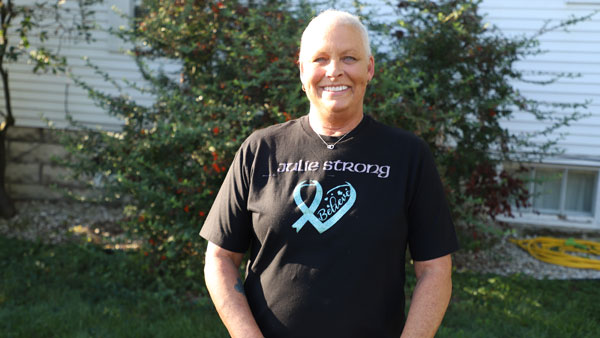Julie O’Leary says she has led a “blessed” life. She is one of six siblings, the mother of three, a grandmother of four and the wife of Ed for 30 years.
“I am such a family person,” the 63-year-old Palmyra, MO, resident exclaimed.

Julie O'Leary
Julie would rely on all her blessings for strength after her most recent annual physical exam with Dr. David Knorr of Blessing’s Palmyra Clinic.
An ultrasound test Julie receives each year to keep track of a non-cancerous cyst on her right kidney discovered a life-threatening condition.
“They found a mass in my left ovary at that time,” said Julie. “In the meantime, I had my OB/GYN appointment (with Dr. Ivan Trinh of Blessing’s Hannibal Clinic). When I went in for that, he could feel the cyst on my ovary.”
Julie became one of the estimated 19,880 women expected to be diagnosed with ovarian cancer during 2022.
She was surprised by the diagnosis because she had experienced no symptoms to lead her to believe anything was wrong.
Dr. Trinh says what Julie experienced is common.
“Ovarian cancer is silent for the majority of its early course,” he said. “Symptoms can be vague and hard to pick up in the early stages. By the time we find the cancer, we’re usually looking at stage III.”
Ivan Trinh, MD
That was the stage of Julie’s cancer. The five-year survival rate of ovarian cancer is 93% when it is caught early. But only 20% of cases are caught when the cancer is in stage I or II. When it is detected in stage III or greater, the survival rate can be as low as 30%, according to the National Ovarian Cancer Coalition and American Cancer Society.
“Everyone is scared when they hear the word cancer,” Julie said. “It was a hard thing to go through, but I am a positive person. It was tougher on my children.”
“My daughter, Jenna, said. ‘Mom, I have not seen you be depressed or cry.’ I said, ‘Jenna, I can’t sit around and do that all day long. That’s no good for me either,’” Julie stated.
What she needed was surgery to remove her ovary and perform a hysterectomy. Then, Julie underwent four chemotherapy treatments and will take a chemotherapy medication every day for one year, under the care of Arif Bari, MD, of Blessing’s Hannibal Clinic and James E. Cary Cancer Center.
Since her surgery and four chemo treatments, Julie has had a CT showing no signs of cancer, and a test that showed no currently identified gene abnormalities that would put her at a high risk for recurrence of the cancer.
“It’s amazing what they can do nowadays,” Julie said.
One thing that cannot be done yet is effectively screen women for ovarian cancer.
“The best thing a woman can do is have annual gynecologic exams,” said Dr. Trinh. “Sometimes ovarian cancers can be identified during pelvic exams. That’s for the average risk patient.”
“For women with a family history of ovarian cancer, or breast cancer, we can delve a bit deeper with a test like an ultrasound,” Dr. Trinh continued. “But for the average risk woman, keep up with yearly pelvic exams and make sure there are no other signs and symptoms of ovarian cancer.”
Signs and symptoms of ovarian cancer may include:
-
Abdominal bloating or swelling.
-
Quickly feeling full when eating.
-
Weight loss.
-
Discomfort in the pelvic area.
-
Fatigue.
-
Back pain.
-
Changes in bowel habits, such as constipation.
-
A frequent need to urinate.
In addition, annual preventive examinations, Julie says having doctors you trust, as she does, makes a big difference.
“Being able to sit down and talk with your doctor and get the answers you need is a big part of reducing your risk,” she concluded.
For more information on:
-
Ovarian cancer, go to cancer.org
-
Blessing cancer services, go to blessinghealth.org/cancer
-
Blessing women’s health services, go to blessinghealth.org/womenshealth
